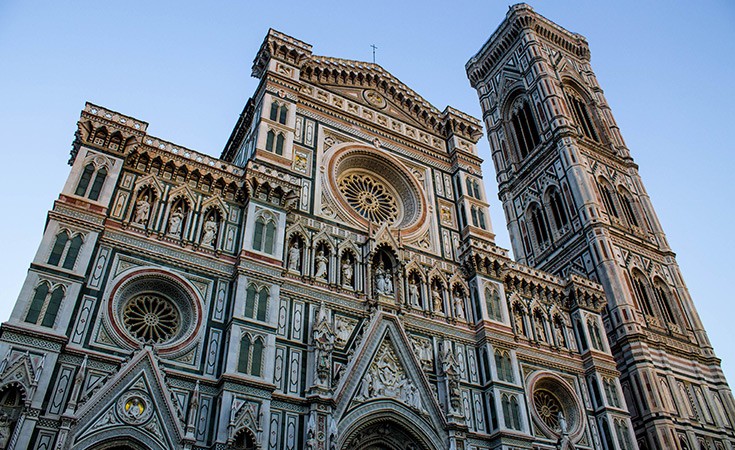
Duomo Cathedral in Florence or, as it is officially called, The Santa Maria del Fiore Cathedral, designed by Arnolfo di Cambio, is the third largest church in the world, just behind the Saint Peter’s Basilica in Rome and The Saint Paul’s Cathedral in London, but used to be the largest in Europe at the time of its completion in the 15th century. It is 153-meters long, 90-meters wide and 90-meters high. The third and last cathedral in Florence, it was named Saint Maria del Fiore in 1412, clearly alluding to the lily flower, the symbol of the city of Florence. The first foundation stone was laid on the 8th September 1296, and the cathedral was designed by Arnolfo di Cambio, who actively participated in the cathedral’s construction between 1296 and 1302. Arnolfo designed the cathedral to have classical elements, with four square bays, a large main altar surrounded by pillars which were to support the dome.
Arnolfo’s design was significantly different to the structures of cathedrals at the time, which is quite noticeable even in the exterior design. On the sides of the building, at its north and south sides, the first four windows are lower, more narrow and closer to one another than the windows on the cathedral’s east and west sides, accommodating the expansion envisioned by master-builder Francesco Talenti, which started in the mid-14th century.
Arnolfo finished two archways and half of the cathedral’s facade, but his sculptures were moved to The Opera del Duomo Museum in 1586, when Great Duke Francesco I Medici decided to build a different facade on the cathedral. When Arnolfo di Cambio died around 1310, progress on the cathedral became slower. In 1334, Giotto was named the new chief architect of the project, and he spent most of his time on the project building the bell tower, but, unfortunately, he died three years later, in 1337. He was replaced by Andrea Pisano, who remained part of the project until 1348, when a great plague hit the city, dropping the number of citizens from 90 thousand to only 45 thousand. Work continued with periods of stagnation until, in 1367, a new and final design for the church was adopted, put forward by 4 architects and 4 painters, including Andrea di Bonauto, Benci and Andrea di Cione, Taddeo Gaddi and Neri di Fioravante.
Between 1349 and 1359, the main supervisor of the project became Francesco Talenti, who succeeded in completing the bell tower and prepared another design with the help of Giovanni di Lapo Ghini. The arc over the central bay was finished in 1378, while the smaller corridors were completed in 1380. Between 1380 and 1421, staircases were constructed, and there is a possibility that the dome itself was completed that same year. On the exterior of the palace, work on marble elements and side entrances, including the Porta dei Canonici to the south, and the Porta della Mandorla to the north, surrounded by statues depicting the ascension of Virgin Mary, finished between 1414 and 1421 by Nanni di Banco. The other two doors are also quite beautiful: Campanile (south), in the second recess, decorations in the style of the school of Andrea Pisano; the Porta della Balla (north), whose name originates from the name of the ancient hole in the defensive walls of Florence in Via de Serva, Borgo di Balla.
Since its completion, the cathedral has been restored many times, the most ambitious of them all being the restorative work done on its facade, which was planned by Emilio de Fabris and completed between 1871 and 1884. Emilio de Fabris tried to reproduce the style of Florentine decorativism from the year 300, which can be seen on the bell tower and the side doors to the cathedral.
 Entrance fee for The Duomo Cathedral
Entrance fee for The Duomo Cathedral
The entrance is free of charge.
(!) It is important to dress suitably for the place you are visiting. Shorts, short skirts, sandals and bare-shouldered shirts are prohibited in the Cathedral.
 Working hours of Duomo Cathedral
Working hours of Duomo Cathedral
The Duomo Cathedral is open between 10am and 4:30pm
Every first Tuesday of the month, the Cathedral is closed for visitors.